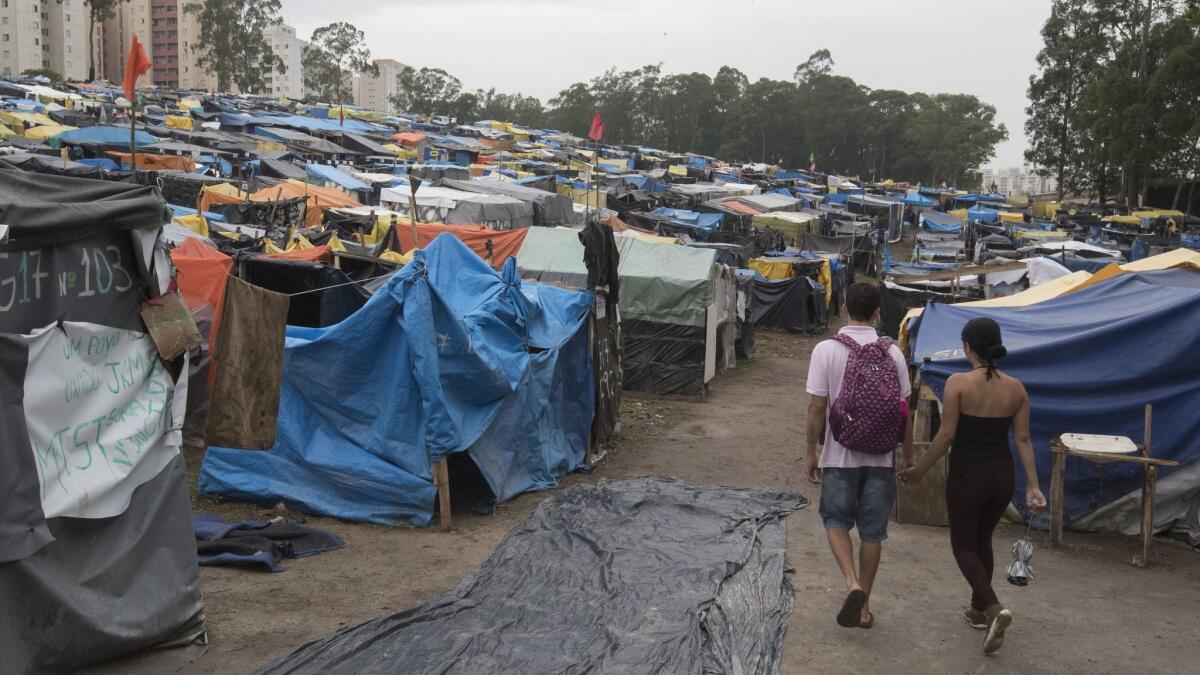Protesters against inequality occupied vacant land in Brazil. Now they’re a mini-city of 8,000 families

- Share via
Reporting from Sao Bernardo do Campo, Brazil — The first 500 arrived at sunrise. They trooped past the handful of homes on their left, up the dusty hill at the end of the street and through the single row of sparse trees to the vacant lot, plastic tarps folded under their arms and wooden posts in hand.
While some quickly mounted makeshift shacks in the calf-high grass, marking where they hoped their permanent homes would someday be built, others went in search of more families to join them — more families desperate for affordable housing.
They weren’t hard to find. Just two months after the Homeless Workers Movement occupied the abandoned land in Sao Bernardo do Campo, an industrial town just outside the mega-city of Sao Paulo, the number of families staking a claim to a piece of it skyrocketed to 8,300.
The group brings together urban workers struggling to find affordable housing, and the encampment was originally meant as a temporary protest.
But the startling speed with which it grew — and the sense of permanence it’s already attained — has turned it into a national symbol of the stark inequalities dividing the well-off from the poor in Brazil. Looming over the camp are rows of tall, handsome apartment buildings.
Since September, the encampment has morphed into its own self-contained city, with mandatory registration and town hall meetings. Its narrow walkways are teeming with improvised homes built just inches from one another, organized into 19 blocks, each with its own communal bathroom and kitchen. Residents show no signs of leaving.
Maria de Almeida Vieira runs the kitchen in G19, the last block to be built, the closest to the encampment’s entrance. It should have followed the order of the other 18 groups — odd numbers on the left, even numbers on the right — but the People Without Fear Occupation ran out of space and had to make do with the small piece of land still available next to G1.
Three young men sit on white plastic lawn chairs and benches made of leftover two-by-fours while on a break from repairing shelters blown over in a recent thunderstorm and delivering 20-liter water jugs to other kitchens. It’s almost noon, and the shade under the overhanging tarp gives a sliver of relief from the biting sun.
Vieira calls to them from behind an open plywood door, “authorized personnel only” painted on it in white.
“Are you boys hungry? Lunch is ready!”
They all get up and stand at the wooden counter as Vieira comes through the door with three plastic plates in hand, each loaded with rice, beans, chicken and salad. Residents of the encampment contribute food when they can, but most meals come from donations from unions and other workers groups.
“Thank you, Ms. Maria,” says Cleiton Alves, kissing the top of her head.
Vieira leans on the counter as she watches Alves and the others eat. They laugh and tell one another stories about jobs they had before they were laid off, before they found shelter here.
“I have five kids and 12 grandkids of my own, but now I have all of you too,” she says, a broad smile on her face. “And I love you all.”

On the other end of the lot, G17’s kitchen is quiet as Selma Pinto Alves finishes lunch. She should be at work now, but she lost her job as a factory production assistant a week earlier.
“Pedro, finish your rice and beans before you go play,” she says to the 6-year-old boy sitting next to her. His mom is working and his dad is trying to get some rest before his night shift, so Pinto Alves is watching Pedro until she has to pick up her 4-year-old daughter, Eloa, from day care.
Pedro scrapes his plate clean and sits on the ground with his yellow dump truck, running it over the rough surface where grass grew before the shacks were built here.
“Living here is fun,” he says, scooping dirt up with his hands and letting it sift through his fingers into the back of the truck. “But I really want to go to Disney World. It has so many rides, and you get to meet Mickey Mouse.”
Pinto Alves and the two men working in the kitchen look at one another and chuckle softly.
“I remember having that dream,” one of them says. “But I realized a long time ago that I was never going to get there.”
Across the encampment in G4, Renata Swiecik pours water into a margarine container for her puppy, Jade. Her nephew, Carlos Henrique, 13, whom she has raised since he was a baby, calls to her daughters, Gabryela, 8, and Beatryz, 6, a few shacks away.
“We’re going to G17,” Beatryz says, referring to the block where Pedro lives. “They have a hose there now to play in the water. But a swimming pool would be better.”
Swiecik smiles and nods slowly, agreeing with her youngest.
“Go ahead and play then,” she says. “But stay in G17. Don’t wander off.”
The kids stay with her mom during the week to be closer to school, but it’s a holiday, so tonight they’ll sleep in the bunk beds Swiecik built. Their shack is just big enough to squeeze in another bed and love seat. Children’s books, stuffed animals and toy cars sit in a corner, and their clothes hang from the beams holding up their roof.
Swiecik watches as the girls disappear around a corner. She’s lucky to have a place here. The encampment is already at capacity, and there’s a waiting list 2,000 families long.
Langlois is a special correspondent.
More to Read
Sign up for Essential California
The most important California stories and recommendations in your inbox every morning.
You may occasionally receive promotional content from the Los Angeles Times.










